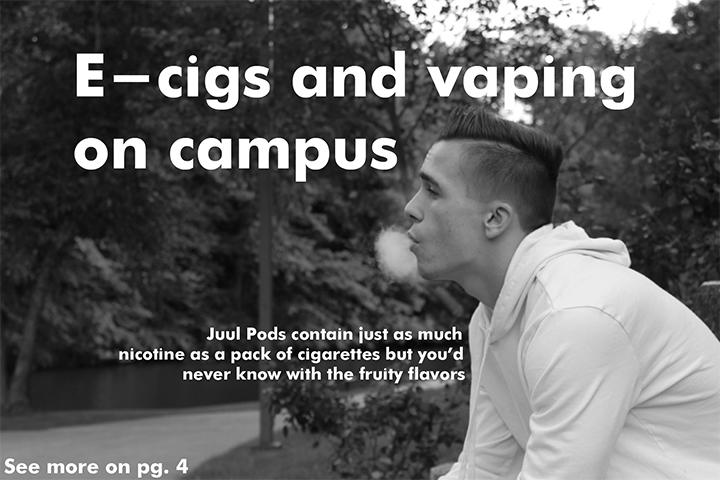Walking across Augustana’s campus, one can surely smell fruity vape and see big clouds of smoke. That may soon be coming to an end.
Earlier this month, the FDA ordered that five e-cigarette brands submit plans within the next 60 days to limit teenager use. If they don’t comply, the FDA may restrict manufacturers from selling flavored products.
“Juul” devices, commonly referred to as “Juuls,” are a popular e-cigarette frequently seen on the Augustana campus, and a quick visit to Juul’s website shows that “The Juul Labs’ mission is to eliminate cigarettes by offering existing adult smokers with a true alternative to combustible cigarettes.” But, many on the opposition claim that teenagers actually started smoking due to Juul, rather than using Juul to quit smoking.
Junior Olivia Helton said she started using an e-cigarette because her friend had one. “After hitting it a few times, I bought my own. I found myself getting addicted to nicotine, so I’m trying to stop.” The main reason she started? The flavor. If there weren’t as many flavors, she said, she probably would not have started.
Junior Storm Curry has a similar story. He’s been smoking for two years now and started because he tried a friend’s and liked the feeling. Soon after, he bought his own. Unlike Helton, the flavor doesn’t affect Curry’s desire as much as the sensation itself. “It’s funny, because a lot of people that use [Juul] know it’s bad,” Curry said.
If you visit Juul’s website and indicate you are under 21, you are redirected to a site titled “Smokefree Teen” organized by the U.S. Department of Health and Human Services. The site provides tips on how to become smoke free, but Juul does not provide a way for those under 21 to view a list of all chemicals in Juul products.
Assistant Professor Rebecca Heick of Augustana’s public health department said that neither cigarette option is risk-free: “The flavoring in e-cigarettes contains diacetyl, which is linked to a rare disease called bronchiolitis obliterans, which causes permanent damage to the bronchioles (the smallest airways in the lungs) and can cause lifelong health effects. All e-cigarettes contain propylene glycol and glycerol. While not dangerous on their own, when they are heated for vaporization, they may decompose into formaldehyde—and in high wattage vaporizers (like most newer e-cigarettes), this is much more likely to occur.” Formaldehyde is a gas used in building materials and household products such as wood.
Heick also adds that nicotine, found in both products, can cause an increase in heart rate and blood pressure that contributes to long-term risks of diabetes. They also pose a change in brain chemistry that “may result in decreased impulse control and even ADHD.”
“Having such a variety of ‘good’ flavor options available with e-cigarettes increases the chance that they will experiment with it. It also creates a false sense that if something is “fruity” or otherwise labeled as having fresh or energizing flavors, it is a healthier option or carries minimal risk of health problems—and that certainly isn’t true. No matter what you flavor them with, e-cigarettes contain nicotine and can produce negative health effects,” Heick said in an email.
Senior public health major Jennifer DiBuono is working on making Augustana tobacco and smoke-free and hopes the policy will be implemented by the 2019-2020 academic year.
“In 2014, Illinois passed a smoke-free campus act, so within all public schools in Illinois you’re not allowed to use tobacco products, which includes e-cigarettes because all nicotine is a derivative from tobacco. Since we’re private, it doesn’t apply to us,” DiBuono said. Since flavored products have been eliminated from traditional cigarettes, DiBuono thinks they need to be eliminated from e-cigs too.
Photo Illustration by Noah Robey.
Categories:
FDA may ban flavored E-Cigs
September 27, 2018
0
More to Discover







































































































